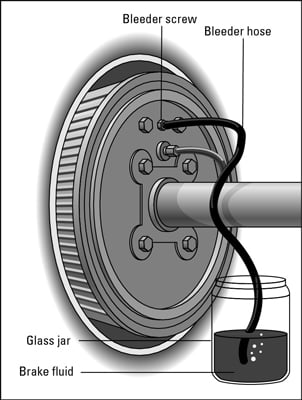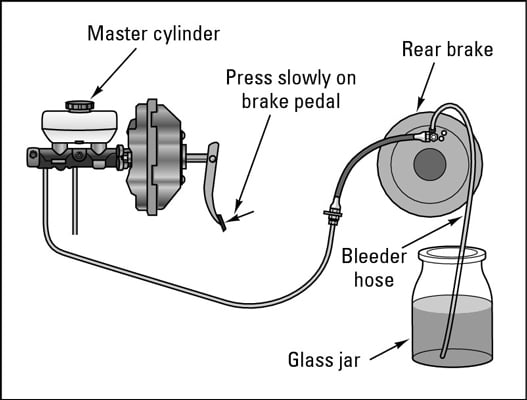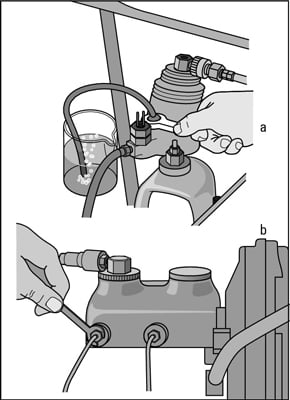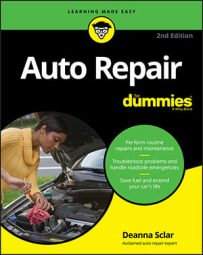If your vehicle has squishy-feeling brakes, the way to get the air out of the lines is to bleed the brakes. To do the job, you need either a brake bleeder wrench or a combination wrench that fits the bleeder nozzle on your vehicle, a can of the proper brake fluid, a clean glass jar, and a friend.
If you have ABS, EBD, BA, or another sophisticated brake system, you should really have a professional bleed the brakes for you to avoid getting air into the actuator.
Follow these steps to bleed your brakes:Find the little nozzle called a brake bleeder screw that’s located behind each of your brakes.

Reaching this bleeder screw may be easier if you jack up the vehicle. If you’re going to crawl underneath, lay down an old blanket or a thick layer of newspapers first. If you really want to be comfortable, beg or borrow a creeper to lie on and slide around with easily.
Pick the proper wrench or socket that fits the screw, and loosen the screw.
Special wrenches called bleeder wrenches fit the bleeder screw and can prevent rounding the screw’s hex-head. Be careful not to break the screw off or you’ll need professional repairs. If it’s stuck, spray some penetrant like WD-40 around the screw. After you loosen the screw, tighten it again (but not too tight).
Place a small piece of flexible hose over the end of the bleeder screw and place the other end of the hose in the jar.
Then fill the jar with brake fluid to cover the end of the hose. If you don’t have anything that fits over the bleeder screw, just keep the jar near the nozzle so that any fluid that squirts out lands in the jar.
Have your friend slowly pump your brake pedal a few times.

Have your friend say “down” when pressing the brake pedal down and “up” when releasing it.
If the vehicle is jacked up, before you let your friend get into it with you underneath it, make sure that the wheels are blocked in the direction in which the car would roll and that it isn’t parked on a hill. Leave your tires in place so that the vehicle will bounce and leave you some clearance if it falls.
After your friend has pumped the pedal a few times and is holding the pedal down, open the bleeder screw.
Brake fluid will squirt out (duck!). If there’s air in your brake lines, air bubbles will be in the fluid. Seeing these bubbles is easiest if you’re using the hose-in-the-jar method, but you can also see them without it.
Before your friend releases the brake pedal, tighten the bleeder screw.
If you don’t, air is sucked back into the brake lines when the pedal is released.
Tell your friend to release the pedal, and listen for them to say “up.”
Repeat this procedure, loosening the screw and tightening it again and again until no more air bubbles come out with the fluid.
Open your master cylinder and add more brake fluid until the level reaches the “Full” line.

If you neglect to make sure the brake level fluid is at “Full,” you run the risk of draining all the fluid out of the master cylinder and drawing air into the lines from the top. If that happens, you have to go back and bleed your master cylinder until you suck the air out of that end of the system. Who needs the extra work?
If you goof and have to bleed the master cylinder, it’s the same deal as bleeding your brakes (friend and all). Just bleed it at the point where the brake lines attach to the cylinder or at the master cylinder’s bleeder nozzle if it has one.
Repeat this process with each brake until the air is out of each brake line.
Don’t forget to add brake fluid to the master cylinder after you bleed each brake.
After you bring the brake fluid level in the master cylinder back to the “Full” level for the last time, drive the vehicle around the block.
The brake pedal should no longer feel spongy when you press it. If it does, check the master cylinder again to be sure that it’s full, and try bleeding the brakes one more time. This situation isn’t unusual, and it doesn’t take as long as it sounds.

